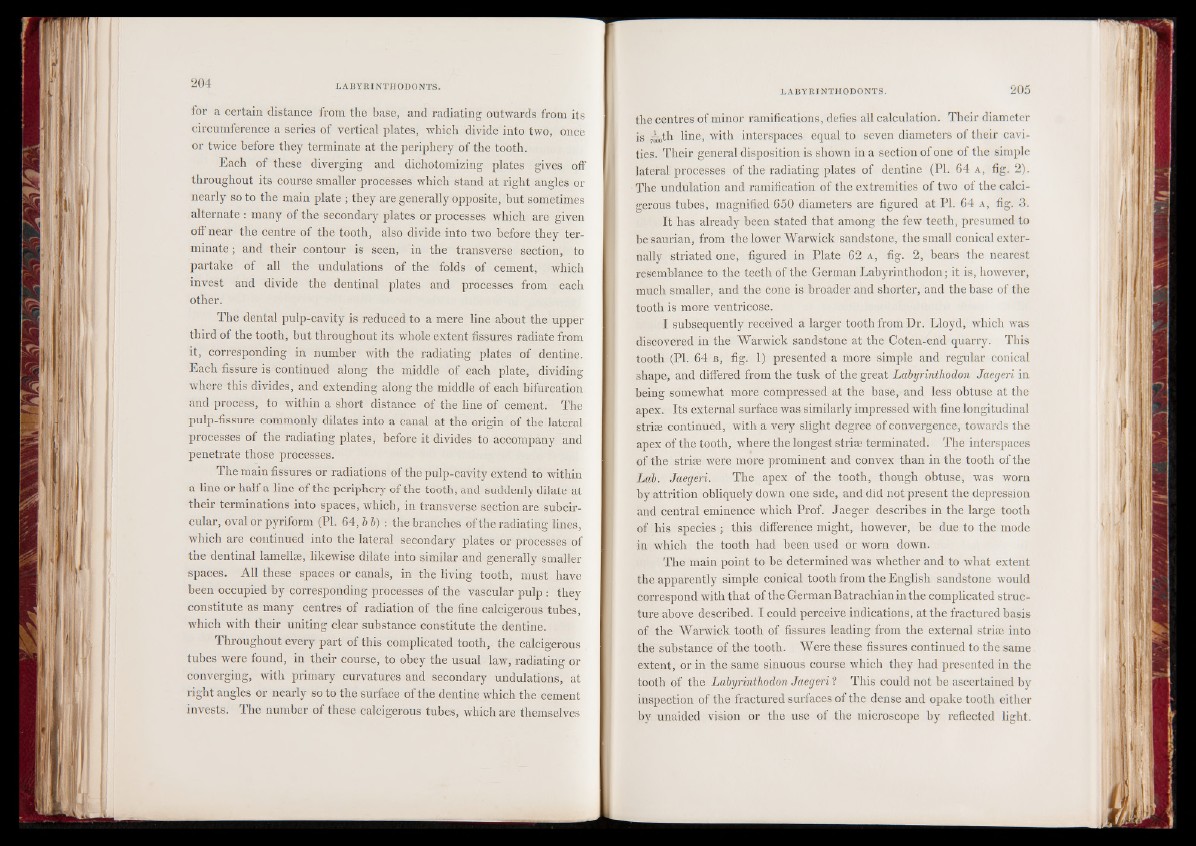
for a certain distance from the base, and radiating outwards from its
circumference a series of vertical plates, which divide into two, once
or twice before they terminate at the periphery of the tooth.
Each of these diverging and dichotomizing plates gives off
throughout its course smaller processes which stand at right angles or
nearly so to the main plate $ they are generally opposite, hut sometimes
alternate | many of the secondary plates or processes which are given
otf near the centre of the tooth, also divide into two before they terminate
; and their contour is seen, in the transverse section, to
partake of all the undulations of the folds of cement, which
invest and divide the dentinal plates and processes from each
other.T
he dental pulp-cavity is reduced to a mere line about the upper
third of the tooth, but throughout its whole extent fissures radiate from
it, corresponding in number with the radiating plates of dentine.
Each fissure is continued along the middle of each plate, dividing
where this divides, and extending along the middle of each bifurcation
and process, to within a short distance of the line of cement. The
pulp-fissure commonly dilates into a canal at the origin of the lateral
processes of the radiating plates, before it divides to accompany and
penetrate those processes.
The main fissures or radiations of the pulp-cavity extend to within
a line or half a line of the periphery of the tooth, and suddenly dilate at
their terminations into spaces, which, in transverse section are subcircular,
oval or pyriform (PI. 64, 6 6) : the branches of the radiating lines,
which are continued into the lateral secondary plates or processes of
the dentinal lamellae, likewise dilate into similar and generally smaller
spaces. All these spaces or canals, in the living tooth, must have
been occupied by corresponding processes of the vascular pulp : they
constitute as many centres of radiation of the fine calcigerous tubes,
which with their uniting clear substance constitute the dentine.
Throughout every part of this complicated tooth, the calcigerous
tubes were found, in their course, to obey the usual law, radiating or
converging, with primary curvatures and secondary undulations, at
right angles or nearly so to the surface of the dentine which the cement
invests. The number of these calcigerous tubes, which are themselves
the centres of minor ramifications, defies all calculation. Their diameter
is 7-^0th line, with interspaces equal to seven diameters of their cavities.
Their general disposition is shown in a section of one of the simple
lateral processes of the radiating plates of dentine (PI. 64 a , fig. 2).
The undulation and ramification of the extremities of two of the calcigerous
tubes, magnified 650 diameters are figured at PL 64 a , fig. 3.
It has already been stated that among the few teeth, presumed to
be saurian, from the krwer Warwick sandstone, the small conical externally
striated one, figured in Plate 62 a , fig. 2, bears the nearest
resemblance to the teeth of the German Labyrinthodon; it is, however,
much smaller, and the cone is broader and shorter, and the base of the
tooth is more ventricose.
I subsequently received a larger tooth from Dr. Lloyd, which was
discovered in the Warwick sandstone at the Coten-end quarry. This
tooth (PL 64 b , fig. 1) presented a more simple and regular conical
shape, and differed from the tusk of the great Labyrinthodon Jaegeri in
being somewhat more compressed at the baseband less obtuse at the
apex. Its external surface was similarly impressed with fine longitudinal
striae continued, with a very slight degree of convergence, towards the
apex of the tooth, where the longest strise terminated. The interspaces
of the strise were more prominent and convex than in the tooth of the
Lab. Jaegeri. The apex of the tooth, though obtuse, was worn
by attrition obliquely down one side, and did not present the depression
and central eminence which Prof. Jaeger describes in the large tooth
of his species ; this difference might, however, be due to the mode
in which the tooth had been used or worn down.
The main point to be determined was whether and to what extent
the apparently simple conical tooth from the English sandstone would
correspond with that of the German Batrachian in the complicated structure
above described. I could perceive indications, at the fractured basis
of the Warwick tooth of fissures leading from the external striae into
the substance- of the tooth. Were these fissures continued to the same
extent, or in the same sinuous course which they had presented in the
tooth of the Labyrinthodon Jaegeri ? This could not be ascertained by
inspection of the fractured surfaces of the dense and opake tooth either
by unaided vision or the use of the microscope by reflected light.